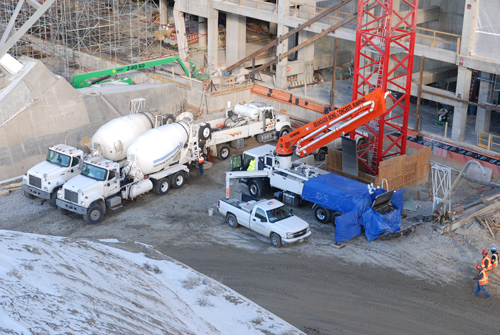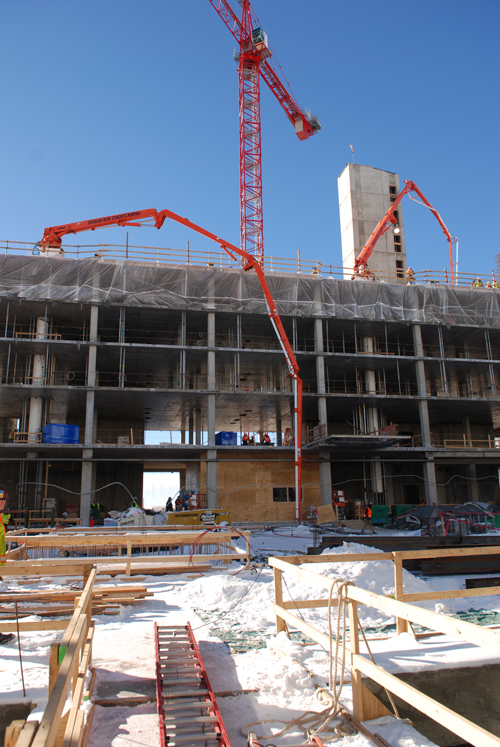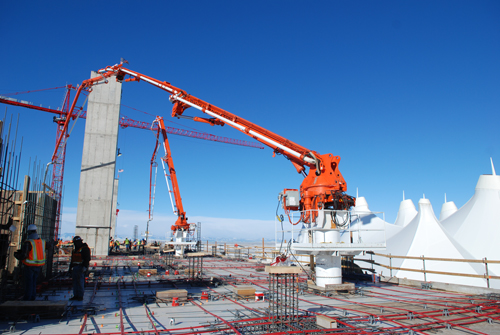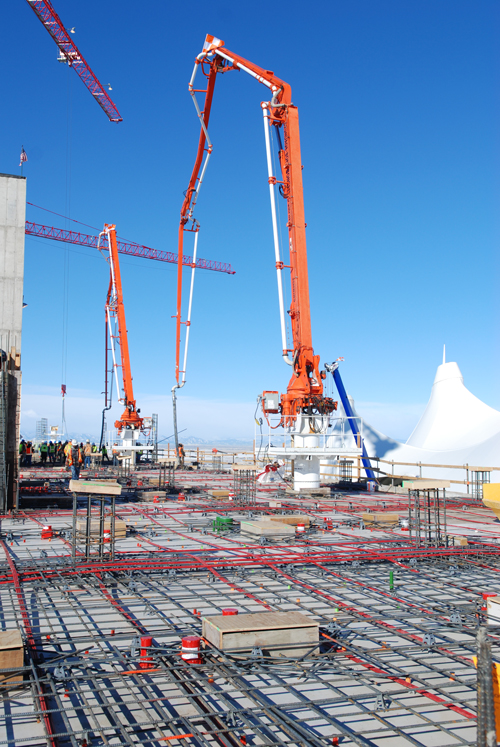Separate Placing Booms Flying To Complete Denver Airport Expansion

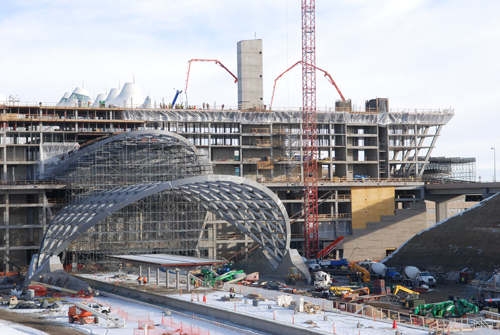
Like air traffic over busy Denver International Airport, separate placing booms are flying regularly over the first major expansion at the site since the early 1990s. A new 516-room hotel and transit center is being constructed and Brundage-Bone Concrete Pumping’s Denver office is supplying the pumping equipment and expertise. Working for construction managers/general contractors, MHS (Mortenson, Hunt, Saunders) A Tri-Venture, Brundage-Bone is pumping the concrete on the 700,000 square-foot South Terminal Redevelopment project using an engineered system of mast-mounted separate placing booms, pipelines and diversion valves.
Because one of Denver Airport’s iconic tents would have to be re-anchored to accommodate construction, two “crucifixes” were buried early in the project. “It was quite a process,” explains Josh Joiner, Brundage-Bone placing boom operations manager, “We had two 39-meter boom pumps working simultaneously to fill the 72-inch diameter caisson that held the temporary support. The crucifixes had to be aligned absolutely perfectly to provide a two-point anchor for one end of the tent.”
The transit center will accommodate light rail trains that will begin transferring passengers 23-miles between Union Station in downtown and the airport in 2016. The large excavation for the station, located at the end of the south terminal, measured approximately 500 by 300-yards when it was started in June of 2012 by Kiewit. Hundreds of caissons were drilled and the voids filled by Brundage-Bone’s Schwing 39-meter concrete pumps. The 60-foot deep drilled caissons each required 30-yards of one-inch minus aggregate mix. In late 2013, Brundage-Bone pumped the slab on grade using “Everything from our Schwing 32-meters to our 61-meters,” according to Joiner. Brundage-Bone’s Denver facility is located 15-miles from the project allowing for fast dispatching as pumps are needed.
“Because of the tight confines of the site, separate placing booms were really the only way to cover this much square footage efficiently,“ explains Joiner. Two 39-meter Schwing separate placing booms with 35-meter horizontal reach were chosen for the project. After boom pumps completed the second level, the booms were attached to 50-foot masts that were mounted in base frames and anchored to level one. Eight access holes were left in the second level and the two booms worked individually and simultaneously to pour the slabs and verticals.
“Moving the booms could take up to an hour,” according to Joiner, “Because the shoring wouldn’t allow the weight of the boom on the deck we had to swing them off the footprint and set them in a cradle on the ground. After we moved the mast, we could remount the booms.” Moving the booms off the masts would have been more difficult but the Schwing units allow the powerpack to be separated from the boom reducing the weight to stay within the capabilities of the tower cranes even when extended. Weight of the SPB 35 is 12,850-lbs without the powerpack and 18,750-lbs combined. After level four was completed the booms and masts were easily transitioned into floor frames. With this mounting method, the masts are held in 41” x 41” metal frames with pins and wedges for faster raising and repositioning.
Feeding the booms from two pumping stations are a Schwing BPL 4000 truck-mounted pump or 32-meter Schwing – both with 2023-5 pump kits. The 32-meter is bypassing the boom and pumping directly from the Rock Valve outlet through a transition and into the pipeline. Two five-inch pipelines are anchored horizontally and vertically to reach the eight boom locations. The pipelines are five-inch, heavy-duty, heat-treated, one-quarter-inch wall with two-bolt, heavy-duty five-inch clamps. Mix designs ranged from 8,000 psi for the verticals and 5,000 psi for the decks. The BPL 4000 and the S 32 X averaged 120 yds./hr pumping at the maximum distance of 700-feet. More than 1,500-feet of pipeline is being utilized on the project. To clean out the line, crews use 120 psi air pressure generated by a 375 cfm air compressor to blow back the clean out balls into ready-mix trucks through a candy cane-shaped outlet at ground level.
After 13 months of pumping, the Brundage-Bone crew is proceeding with the 10-story Westin hotel that is being built on top of the transit center. The hotel dimensions are smaller than the five-level train station which reduces the required number of mast locations to four. “Now the tower crane can pick the boom and powerpack together so flying and remounting only takes a half-hour,” Josh notes. The 480-volt powerpack features quick-connect hydraulic hoses to speed the process. The placing booms 4-section Roll and Fold boom reaches 114-feet horizontally allowing more than 40,000 square feet to be poured from one location. “The Roll and Fold booms are ideal for this application because all of the articulation is on the bottom side of the boom, where we can use it,” explains Joiner. The versatility of the boom means operators can pour right up to the mast at any elevation with precision using the wireless proportional boom controls. Crews are on a 10-day pour schedule for each hotel floor that is divided into four separate pours.
Concrete pumping is dependent on temperature and wind speed. Pumping is halted if the temperature reaches single digits and, due to limitations of the tower cranes, booms can’t be flown if winds are more than 30 mph. Brundage-Bone expects to top out the hotel in May.
Currently, there are 147 firms working on the South Terminal Redevelopment Program, which, when completed in 2016 will house the train station, baggage and TSA security facilities for arriving and departing passengers. “By completing this project we are finally realizing the original vision for Denver International Airport,” stated Michael Hancock, mayor of Denver.
Denver International Airport is the 11th-busiest airport in the world and the fifth-busiest airport in the United States. With more than 50 million passengers traveling through the airport each year, it is one of the busiest airline hubs in the United States. Denver Airport is the primary economic engine for the state of Colorado, generating more than $22 billion for the region annually.
Specs:
Project: Denver International Airport South Terminal Redevelopment Program
Architect: Gensler, Denver, CO
Construction Manager/General Contractor: MHS (Mortenson, Hunt, Saunders) A Tri-Venture, Denver, CO
Concrete Pumping Contractor: Brundage-Bone, Denver, CO
Equipment: Schwing BPL 4000, Schwing S 32 SX, two SPB 39-meter Schwing, separate placing booms



